Gladiolus
| Gladiolus | |
|---|---|
| | |
| Gladiolus | |
| Scientific classification | |
| Kingdom: | Plantae |
| (unranked): | Angiosperms |
| (unranked): | Monocots |
| Order: | Asparagales |
| Family: | Iridaceae |
| Subfamily: | Ixioideae |
| Tribe: | Ixieae |
| Genus: | Gladiolus L. |
| Type species | |
| Gladiolus communis L. | |
| Species | |
|
About 260, see text | |
| Synonyms[1] | |
| |
Gladiolus (from Latin, the diminutive of gladius, a sword) is a genus of perennial cormous flowering plants in the iris family (Iridaceae).[2]
It is sometimes called the 'sword lily', but usually by its generic name (plural gladioli).[3]
The genus occurs in Asia, Mediterranean Europe, South Africa, and tropical Africa. The center of diversity is in the Cape Floristic Region.[4] The genera Acidanthera, Anomalesia, Homoglossum, and Oenostachys, formerly considered distinct, are now included in Gladiolus.[5]
Description
The genus Gladiolus contains about 260 species, of which 250 are native to sub-Saharan Africa, mostly South Africa. About 10 species are native to Eurasia. There are 160 species of Gladiolus endemic in southern Africa and 76 in tropical Africa. The flowers of unmodified wild species vary from very small to perhaps 40 mm across, and inflorescences bearing anything from one to several flowers. The spectacular giant flower spikes in commerce are the products of centuries of hybridisation, selection, and perhaps more drastic manipulation.
Gladioli are half-hardy in temperate climates. They grow from rounded, symmetrical corms, that are enveloped in several layers of brownish, fibrous tunics.
Their stems are generally unbranched, producing 1 to 9 narrow, sword-shaped, longitudinal grooved leaves, enclosed in a sheath. The lowest leaf is shortened to a cataphyll. The leaf blades can be plane or cruciform in cross section.
The flower spikes are large and one-sided, with secund, bisexual flowers, each subtended by 2 leathery, green bracts. The sepals and the petals are almost identical in appearance, and are termed tepals. They are united at their base into a tube-shaped structure. The dorsal tepal is the largest, arching over the three stamens. The outer three tepals are narrower. The perianth is funnel-shaped, with the stamens attached to its base. The style has three filiform, spoon-shaped branches, each expanding towards the apex.
The ovary is 3-locular with oblong or globose capsules, containing many, winged brown, longitudinally dehiscent seeds. In their center must be noticeable the specific pellet-like structure which is the real seed without the fine coat. In some seeds this feature is wrinkled with black color. These seeds are unable to germinate.
These flowers are variously colored, pink to reddish or light purple with white, contrasting markings, or white to cream or orange to red.
The South African species were originally pollinated by long-tongued anthrophorine bees, but some changes in the pollination system have occurred, allowing pollination by sunbirds, noctuid and Hawk-moths, long-tongued flies and several others. In the temperate zones of Europe many of the hybrid large flowering sorts of gladiolus can be pollinated by small well-known wasps. Actually, they are not very good pollinators because of the large flowers of the plants and the small size of the wasps. Another insect in this zone which can try some of the nectar of the gladioli is the best-known European Hawk-moth Macroglossum stellatarum which usually pollinates many popular garden flowers like Petunia, Zinnia, Dianthus and others.
Gladioli are used as food plants by the larvae of some Lepidoptera species including the Large Yellow Underwing. The Gladioli is also the official flower of Elmira Ontario in Canada adopted by the council on March 15, 1926.
Gladioli have been extensively hybridized and a wide range of ornamental flower colours are available from the many varieties. The main hybrid groups have been obtained by crossing between four or five species, followed by selection: Grandiflorus, Primulines and Nanus. They make very good cut flowers.
The majority of the species in this genus are diploid with 30 chromosomes but the Grandiflora hybrids are tetraploid and possess 60 chromosomes. This is because the main parental species of these hybrids is Gladiolus dalenii which is also tetraploid and includes a wide range of varieties (like the Grandiflora hybrids).
Species
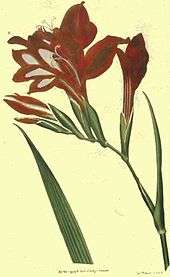
from Curtis's Botanical Magazine 1790
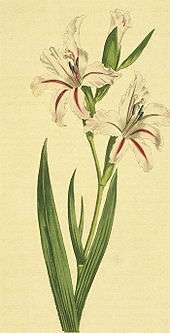
from Curtis's Botanical Magazine 1801

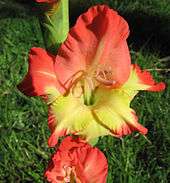
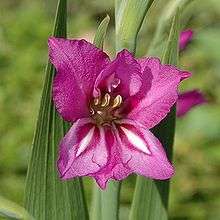

The genus Gladiolus has been divided into many sections. Most species, however, are only tentatively placed. As of June 2014, the World Checklist of Selected Plant Families accepts 276 species:[6]
- Gladiolus abbreviatus Andrews
- Gladiolus abyssinicus (Brongn. ex Lem.) B.D.Jacks.
- Gladiolus actinomorphanthus P.A.Duvign. & Van Bockstal
- Gladiolus acuminatus F.Bol.
- Gladiolus aequinoctialis Herb.
- Gladiolus alatus L. (sect. Hebea)
- Gladiolus albens Goldblatt & J.C.Manning
- Gladiolus amplifolius Goldblatt
- Gladiolus anatolicus (Boiss.) Stapf
- Gladiolus andringitrae Goldblatt
- Gladiolus angustus L. (sect. Blandus) - long-tubed painted lady
- Gladiolus antakiensis A.P.Ham.
- Gladiolus antandroyi Goldblatt
- Gladiolus appendiculatus G.Lewis
- Gladiolus aquamontanus Goldblatt & Vlok
- Gladiolus arcuatus Klatt
- Gladiolus atropictus Goldblatt & J.C.Manning
- Gladiolus atropurpureus Baker
- Gladiolus atroviolaceus Boiss.
- Gladiolus attilae Kit Tan
- Gladiolus aurantiacus Klatt
- Gladiolus aureus Baker - golden gladiolus
- Gladiolus balensis Goldblatt
- Gladiolus baumii Harms
- Gladiolus bellus C. H. Wright
- Gladiolus benguellensis Baker (sect. Ophiolyza)
- Gladiolus bilineatus G. J. Lewis
- Gladiolus blommesteinii L.Bolus
- Gladiolus bojeri (Baker) Goldblatt
- Gladiolus bonaespei Goldblatt & M.P.de Vos
- Gladiolus boranensis Goldblatt
- Gladiolus brachyphyllus Bolus f.
- Gladiolus brevifolius Jacq. (sect. Linearifolius)
- Gladiolus brevitubus G. Lewis
- Gladiolus buckerveldii (L. Bolus) Goldblatt
- Gladiolus bullatus Thunb. ex G. Lewis - Caledon bluebell
- Gladiolus caeruleus Goldblatt & J.C. Manning
- Gladiolus calcaratus G. Lewis
- Gladiolus calcicola Goldblatt
- Gladiolus canaliculatus Goldblatt
- Gladiolus candidus (Rendle) Goldblatt
- Gladiolus cardinalis Curtis (sect. Blandus)
- Gladiolus carinatus Aiton
- Gladiolus carmineus C. H. Wright (sect. Blandus) - cliff lily
- Gladiolus carneus F.Delaroche (sect. Blandus) - large painted lady
- Gladiolus caryophyllaceus (Burm. f.) Poiret
- Gladiolus cataractarum Oberm.
- Gladiolus caucasicus Herb.
- Gladiolus ceresianus L. Bolus
- Gladiolus chelamontanus Goldblatt
- Gladiolus chevalierianus Marais
- Gladiolus communis L. (sect. Gladiolus) - cornflag (type species)
- Gladiolus comptonii G.J.Lewis
- Gladiolus crassifolius Baker
- Gladiolus crispulatus L. Bolus
- Gladiolus cruentus T. Moore (sect. Ophiolyza)
- Gladiolus cunonius (L.) Gaertn.
- Gladiolus curtifolius Marais
- Gladiolus curtilimbus P.A.Duvign. & Van Bockstal ex S.Córdova
- Gladiolus cylindraceus G. Lewis
- Gladiolus dalenii Van Geel (sect. Ophiolyza)
- Gladiolus davisoniae F.Bolus
- Gladiolus debeerstii De Wild.
- Gladiolus debilis Ker Gawler (sect. Homoglossum) - small painted lady
- Gladiolus decaryi Goldblatt
- Gladiolus decoratus Baker
- Gladiolus delpierrei Goldblatt
- Gladiolus densiflorus Baker
- Gladiolus deserticola Goldblatt
- Gladiolus dichrous (Bullock) Goldblatt
- Gladiolus diluvialis Goldblatt & J.C.Manning
- ' 'Gladiolus dolichosiphon Goldblatt & J.C.Manning
- Gladiolus dolomiticus Oberm.
- Gladiolus dzavakheticus Eristavi
- Gladiolus ecklonii Lehm.
- Gladiolus elliotii Baker (sect. Ophiolyza)
- Gladiolus emiliae L. Bolus
- Gladiolus engysiphon G. Lewis
- Gladiolus equitans Thunb. (sect. Hebea)
- Gladiolus erectiflorus Baker
- Gladiolus exiguus G. Lewis
- Gladiolus exilis G.J.Lewis
- Gladiolus fenestratus Goldblatt
- Gladiolus ferrugineus Goldblatt & J.C.Manning
- Gladiolus filiformis Goldblatt & J.C.Manning
- Gladiolus flanaganii Baker - suicide gladiolus
- Gladiolus flavoviridis Goldblatt
- Gladiolus floribundus Jacq.
- Gladiolus fourcadei (L.Bolus) Goldblatt & M.P.de Vos
- Gladiolus geardii L. Bolus
- Gladiolus goldblattianus Geerinck
- Gladiolus gracilis Jacq. (sect. Homoglossum) - reed bells
- Gladiolus gracillimus Baker
- Gladiolus grandiflorus Andrews (sect. Blandus)
- Gladiolus grantii Baker
- Gladiolus gregarius Welw. ex Baker (sect. Densiflorus)
- Gladiolus griseus Goldblatt & J.C. Manning
- Gladiolus gueinzii Kunze
- Gladiolus gunnisii (Rendle) Marais
- Gladiolus guthriei F. Bol. (sect. Linearifolius)
- Gladiolus hajastanicus Gabrieljan
- Gladiolus halophilus Boiss. & Heldr.
- Gladiolus harmsianus Vaupel
- Gladiolus hirsutus Jacq. (sect. Linearifolius) - small pink Afrikaner, lapmuis
- Gladiolus hollandii L. Bolus
- Gladiolus horombensis Goldblatt
- Gladiolus huillensis (Welw. ex Baker) Goldblatt
- Gladiolus humilis Stapf
- Gladiolus huttonii (N.E.Br.) Goldblatt & M.P.de Vos
- Gladiolus hyalinus Jacq.
- Gladiolus illyricus W.D.J.Koch - wild gladiolus
- Gladiolus imbricatus L.
- Gladiolus inandensis Baker
- Gladiolus inflatus Thunb.
- Gladiolus inflexus Goldblatt & J.C. Manning
- Gladiolus insolens Goldblatt & J.C. Manning
- Gladiolus intonsus Goldblatt
- Gladiolus invenustus G. J. Lewis
- Gladiolus involutus D.Delaroche (sect. Hebea)
- Gladiolus iroensis (A. Chev.) Marais
- Gladiolus italicus P. Mill. (sect. Gladiolus) - Italian gladiolus, cornflag
- Gladiolus jonquilodorus Eckl. ex G.J.Lewis
- Gladiolus juncifolius Goldblatt
- Gladiolus kamiesbergensis G. Lewis
- Gladiolus karooicus Goldblatt & J.C.Manning
- Gladiolus kotschyanus Boiss.
- Gladiolus lapeirousioides Goldblatt
- Gladiolus laxiflorus Baker
- Gladiolus ledoctei P.A.Duvign. & Van Bockstal
- Gladiolus leonensis Marais
- Gladiolus leptosiphon Bolus f.
- Gladiolus liliaceus Houtt. (sect. Homoglossum)
- Gladiolus linearifolius Vaupel
- Gladiolus lithicola Goldblatt
- Gladiolus longicollis Baker (sect. Homoglossum)
- Gladiolus longispathaceus Cufod.
- Gladiolus loteniensis Hilliard & Burtt
- Gladiolus lundaensis Goldblatt
- Gladiolus luteus Lam.
- Gladiolus macneilii Oberm.
- Gladiolus maculatus Sweet
- Gladiolus magnificus (Harms) Goldblatt
- Gladiolus malvinus Goldblatt & J.C. Manning
- Gladiolus manikaensis Goldblatt
- Gladiolus marlothii G. Lewis
- Gladiolus martleyi L. Bolus (sect. Homoglossum)
- Gladiolus meliusculus (G. Lewis) Goldblatt & J.C. Manning
- Gladiolus melleri Baker (sect. Ophiolyza)
- Gladiolus menitskyi Gabrieljan
- Gladiolus mensensis (Schweinf.) Goldblatt
- Gladiolus meridionalis G.J.Lewis
- Gladiolus metallicola Goldblatt
- Gladiolus micranthus Baker, 1901
- Gladiolus microcarpus G. Lewis
- Gladiolus microspicatus P.A.Duvign. & Van Bockstal ex S.Córdova
- Gladiolus miniatus Eckl.
- Gladiolus mirus Vaupel
- Gladiolus monticola G. Lewis ex Goldblatt & J.C. Manning
- Gladiolus mosambicensis Baker
- Gladiolus mostertiae L. Bolus
- Gladiolus muenzneri F. Vaup
- Gladiolus murgusicus Mikheev
- Gladiolus murielae Kelway (syn. G. callianthus) – Abyssinian gladiolus
- Gladiolus mutabilis G.J.Lewis
- Gladiolus negeliensis Goldblatt
- Gladiolus nerineoides G. Lewis
- Gladiolus nigromontanus Goldblatt
- Gladiolus nyasicus Goldblatt
- Gladiolus oatesii Rolfe
- Gladiolus ochroleucus Baker (sect. Densiflorus)
- Gladiolus oliganthus Baker
- ' 'Gladiolus oligophlebius Baker
- Gladiolus oppositiflorus Herbert (sect. Ophiolyza)
- Gladiolus orchidiflorus Andrews (sect. Hebea)
- Gladiolus oreocharis Schltr.
- Gladiolus ornatus Klatt
- Gladiolus overbergensis Goldblatt & M.P.de Vos
- Gladiolus palustris Gaudin - marsh gladiolus
- Gladiolus papilio Hook. f. (sect. Densiflorus) - goldblotch gladiolus
- Gladiolus pappei Baker (sect. Blandus)
- Gladiolus pardalinus Goldblatt & J.C. Manning
- Gladiolus parvulus Schltr.
- Gladiolus patersoniae Bolus f.
- Gladiolus pauciflorus Baker ex Oliv.
- Gladiolus pavonia Goldblatt & J.C. Manning
- Gladiolus permeabilis Delaroche (sect. Hebea)
- Gladiolus perrieri Goldblatt
- Gladiolus persicus Boiss.
- Gladiolus phoenix Goldblatt & J.C.Manning
- Gladiolus pole-evansii Verd.
- Gladiolus praecostatus Marais
- Gladiolus pretoriensis Kuntze
- Gladiolus priorii (N. E. Br.) Goldblatt & De Vos
- Gladiolus pritzelii Diels
- Gladiolus puberulus Vaupel
- Gladiolus pubigerus G. Lewis
- Gladiolus pulcherrimus (G. Lewis) Goldblatt & J.C. Manning
- Gladiolus pungens P.A.Duvign. & Van Bockstal ex S.Córdova
- Gladiolus pusillus Goldblatt
- Gladiolus quadrangularis (Burm. f.) Ker Gawler
- Gladiolus quadrangulus (Delaroche) Barnard
- Gladiolus recurvus L. (sect. Homoglossum)
- Gladiolus reginae Goldblatt & J.C.Manning
- Gladiolus rehmannii Baker
- Gladiolus rhodanthus J.C.Manning & Goldblatt
- Gladiolus richardsiae Goldblatt
- Gladiolus robertsoniae Bolus f.
- Gladiolus robiliartianus P.A.Duvign.
- Gladiolus rogersii Baker
- Gladiolus roseolus Chiov.
- Gladiolus roseovenosus Goldblatt & J.C. Manning
- Gladiolus rubellus Goldblatt
- Gladiolus rudis Lichtst. ex Roem. & Schult.
- Gladiolus rufomarginatus G.J.Lewis
- Gladiolus rupicola F. Vaupel
- Gladiolus saccatus (Klatt) Goldblatt & M.P. de Vos
- Gladiolus salmoneicolor P.A.Duvign. & Van Bockstal ex S.Córdova
- Gladiolus salteri G. Lewis
- Gladiolus saundersii Hook. f. - Saunders' gladiolus, Lesotho lily
- Gladiolus saxatilis Goldblatt & J.C.Manning
- Gladiolus scabridus Goldblatt & J.C.Manning
- Gladiolus schweinfurthii Baker
- Gladiolus scullyi Baker
- Gladiolus sekukuniensis P.J.D.Winter
- Gladiolus sempervirens G.J.Lewis
- Gladiolus serapiiflorus Goldblatt
- Gladiolus serenjensis Goldblatt
- Gladiolus sericeovillosus Hook. f.
- Gladiolus serpenticola Goldblatt & J.C. Manning
- Gladiolus somalensis Goldblatt & Thulin
- Gladiolus speciosus Thunb.
- Gladiolus splendens (Sweet) Herbert
- Gladiolus stefaniae Oberm.
- Gladiolus stellatus G. Lewis
- Gladiolus stenolobus Goldblatt
- Gladiolus stenosiphon Goldblatt
- Gladiolus stokoei G.J.Lewis
- Gladiolus subcaeruleus G. Lewis
- Gladiolus sudanicus Goldblatt
- Gladiolus sufflavus (G. Lewis) Goldblatt & J.C. Manning
- Gladiolus sulculatus Goldblatt
- Gladiolus symonsii F.Bolus
- Gladiolus szovitsii Grossh.
- Gladiolus taubertianus Schltr.
- Gladiolus tenuis M. Bieb.
- Gladiolus teretifolius Goldblatt & De Vos
- Gladiolus trichonemifolius Ker Gawl. (sect. Homoglossum)
- Gladiolus triphyllus (Sm.) Ker Gawl.
- Gladiolus tristis L. (sect. Homoglossum)
- Gladiolus tshombeanus P.A.Duvign. & Van Bockstal
- Gladiolus uitenhagensis Goldblatt & Vlok
- Gladiolus undulatus L. (sect. Blandus) - large white Afrikaner, wall gladiolus
- Gladiolus unguiculatus Baker
- Gladiolus usambarensis Marais ex Goldblatt
- Gladiolus uysiae L. Bolus ex G. Lewis
- Gladiolus vaginatus Bolus f. (sect. Homoglossum)
- Gladiolus vandermerwei (L. Bolus) Goldblatt & De Vos
- Gladiolus variegatus (G.J.Lewis) Goldblatt & J.C.Manning
- Gladiolus varius Bolus f.
- Gladiolus velutinus De Wild.
- Gladiolus venustus G. Lewis (sect. Hebea)
- Gladiolus verdickii De Wild. & T.Durand
- Gladiolus vernus Oberm.
- Gladiolus vigilans Barnard
- Gladiolus vinosomaculatus Kies
- Gladiolus violaceolineatus G.J.Lewis
- Gladiolus virescens Thunb. (sect. Hebea)
- Gladiolus virgatus Goldblatt & J.C.Manning
- Gladiolus viridiflorus G. Lewis
- Gladiolus watermeyeri L.Bolus (sect. Hebea)
- Gladiolus watsonioides Baker - Mackinder's gladiolus
- Gladiolus watsonius Thunb. (sect. Homoglossum)
- Gladiolus wilsonii (Baker) Goldblatt & J.C.Manning
- Gladiolus woodii Baker
- Gladiolus zambesiacus Baker
- Gladiolus zimbabweensis Goldblatt
Known hybrids include:
- Gladiolus × colvillei (G. cardinalis × G. tristis): Colville's gladiolus
- Gladiolus × gandavensis (G. dalenii × G. oppositiflorus) (sect. Ophiolyza)
- Gladiolus × hortulanus
Cultivation
In temperate zones, the corms of most species and hybrids should be lifted in autumn and stored over winter in a frost-free place, then replanted in spring. Some species from Europe and high altitudes in Africa, as well as the small 'Nanus' hybrids, are much hardier (to at least -15 °F/-26 °C) and can be left in the ground in regions with sufficiently dry winters. 'Nanus' is hardy to Zones 5-8. The large-flowered types require moisture during the growing season, and must be individually staked as soon as the sword-shaped flower heads appear. The leaves must be allowed to die down naturally before lifting and storing the corms. Plants are propagated either from small cormlets produced as offsets by the parent corms, or from seed. In either case, they take several years to get to flowering size. Clumps should be dug up and divided every few years to keep them vigorous.
In culture
- The Mancunian singer Morrissey is known to dance with gladioli hanging from his back pocket or in his hands, especially during the era of The Smiths.[7] This trait of his was made known in the music video for "This Charming Man", where he swung a bunch of yellow gladioli while singing.[8]
- The Australian comedian and personality Dame Edna Everage's signature flowers are gladioli, which she refers to as "glads".[9]
- Gladioli are the flowers associated with a fortieth wedding anniversary.
- Gladiolus is the flower of August.
- "Gladiolus" was the word Frank Neuhauser correctly spelled to win the 1st National Spelling Bee in 1925.
- Gladiolus in art
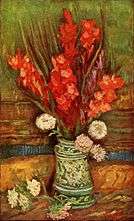 Vase with Red Gladioli (1886) by Vincent van Gogh
Vase with Red Gladioli (1886) by Vincent van Gogh- Gladiole by Philipp Ernst
References
- ↑ "Gladiolus". Royal Botanic Gardens, Kew: World Checklist of Selected Plant Families. Retrieved 10 April 2014.
- ↑ Manning, John; Goldblatt, Peter (2008). The Iris Family: Natural History & Classification. Portland, Oregon: Timber Press. pp. 138–42. ISBN 0-88192-897-6.
- ↑ Shorter Oxford English dictionary: 6th edition. United Kingdom: Oxford University Press. 2007. ISBN 0199206872.
- ↑ Goldblatt, P. &, J.C. Manning. Gladiolus in Southern Africa : Systematics, Biology, and Evolution. Fernwood Press, Cape Town; 1998.
- ↑ GOLDBLATT P. & DE VOS M. P. The reduction of Oenostachys, Homoglossum and Anomalesia, putative sunbird pollinated genera, in Gladiolus L. (Iridaceae-Ixioideae). Bulletin du Muséum national d'histoire naturelle. Section B, Adansonia 11 (4): 417–428, 1989.
- ↑ "Search for Gladiolus". World Checklist of Selected Plant Families. Royal Botanic Gardens, Kew. Retrieved 2014-06-13.
- ↑ "BBC NEWS - Entertainment - Rainy-day voice of a generation". bbc.co.uk.
- ↑ YouTube. youtube.com.
- ↑ Dame Edna Everage and gladioli
Bibliography
- G R Delpierre and N M du Plessis (1974) - The winter-growing Gladioli of Southern Africa. 120 colour photographs and descriptions; (Tafelberg-Uitgewers Beperk)
- Peter Goldblatt (1996)- A monograph of the genus Gladiolus in tropical Africa (83 species) (Timber Press)
- Peter Goldblatt, J.C. Manning (1998)- Gladiolus in southern Africa : Systematics, Biology, and Evolution, including 144 watercolor paintings; (Fernwood Press, Cape Town)
External links
| Wikimedia Commons has media related to Gladiolus. |
| Wikisource has the text of the 1911 Encyclopædia Britannica article Gladiolus. |
- Dressler, S.; Schmidt, M. & Zizka, G. (2014). [http://www.africanplants.senckenberg.de/root/index.php?submitForm=true&page_id=77&searchTextMenue=Gladiolus&filterRegionIDs[]=6&filterRegionIDs[]=1&filterRegionIDs[]=2&filterRegionIDs[]=3&filterRegionIDs[]=5 "Gladiolus"]. African plants – a Photo Guide. Frankfurt/Main: Forschungsinstitut Senckenberg.
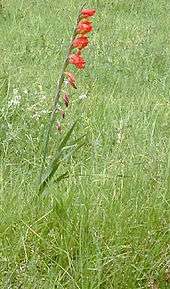
.jpg)